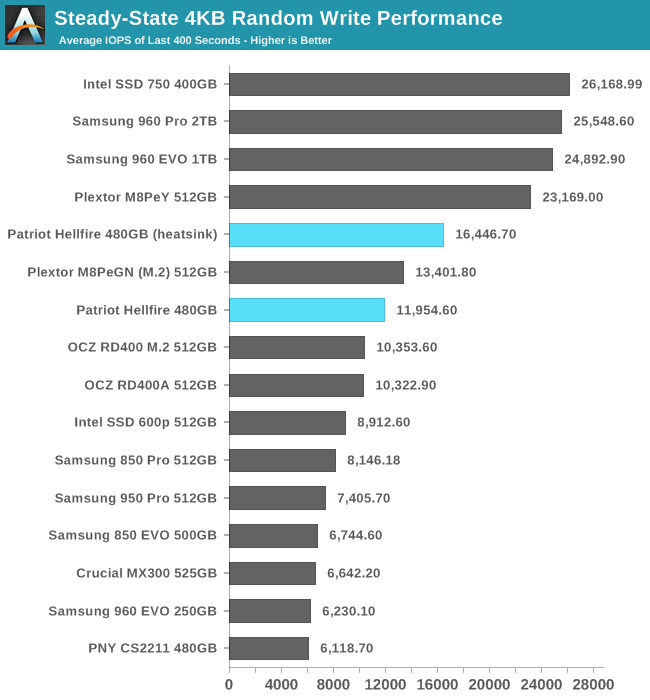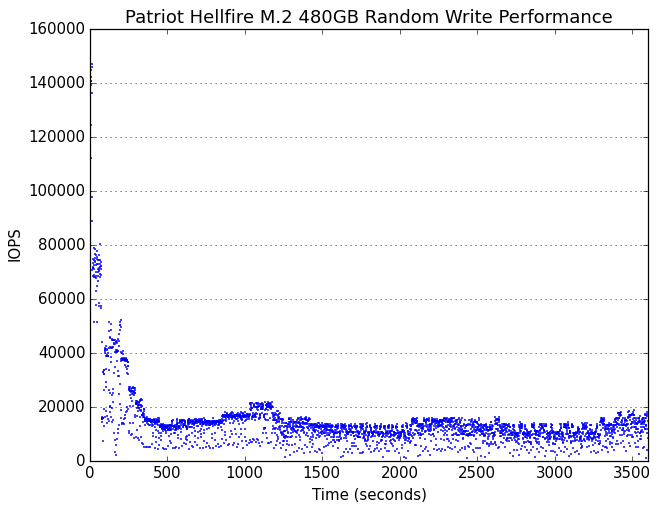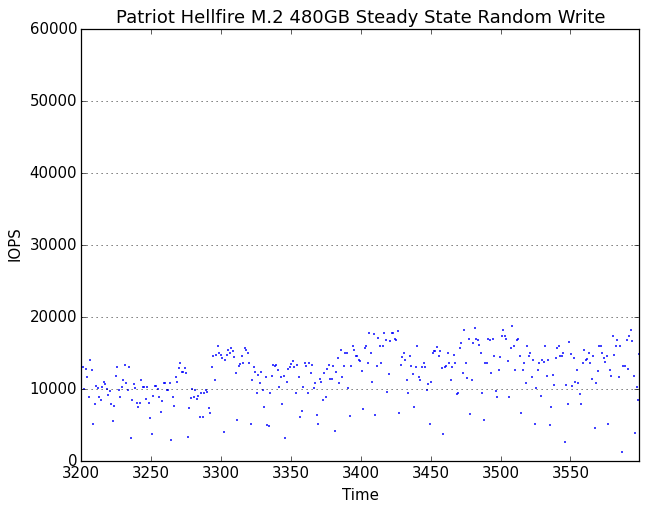The Patriot Hellfire M.2 480GB Review: Phison NVMe Tested
by Billy Tallis on February 10, 2017 8:30 AM ESTPerformance Consistency
Our performance consistency test explores the extent to which a drive can reliably sustain performance during a long-duration random write test. Specifications for consumer drives typically list peak performance numbers only attainable in ideal conditions. The performance in a worst-case scenario can be drastically different as over the course of a long test drives can run out of spare area, have to start performing garbage collection, and sometimes even reach power or thermal limits.
In addition to an overall decline in performance, a long test can show patterns in how performance varies on shorter timescales. Some drives will exhibit very little variance in performance from second to second, while others will show massive drops in performance during each garbage collection cycle but otherwise maintain good performance, and others show constantly wide variance. If a drive periodically slows to hard drive levels of performance, it may feel slow to use even if its overall average performance is very high.
To maximally stress the drive's controller and force it to perform garbage collection and wear leveling, this test conducts 4kB random writes with a queue depth of 32. The drive is filled before the start of the test, and the test duration is one hour. Any spare area will be exhausted early in the test and by the end of the hour even the largest drives with the most overprovisioning will have reached a steady state. We use the last 400 seconds of the test to score the drive both on steady-state average writes per second and on its performance divided by the standard deviation.

The Patriot Hellfire maintains a higher average random write speed than the significantly more expensive OCZ RD400 and the older Samsung 950 PRO, but the Plextor M8Pe performs even better, especially when heatsinks are used.

The Patriot Hellfire does not have the very high consistency of the Intel SSD 750 or most of Samsung's SSDs, but the score is not worryingly low. For consumer-oriented products, consistency under sustained write load is generally a lower priority than high burst performance and quick recovery during idle times.
 |
|||||||||
| Default | |||||||||
| 25% Over-Provisioning | |||||||||
The Patriot Hellfire shows some long-term fluctuations in random write performance, especially when equipped with a heatsink to allow for higher peak performance. With extra overprovisioning, the long-term trend is very stable and the effect of the heatsink is greatly reduced.
 |
|||||||||
| Default | |||||||||
| 25% Over-Provisioning | |||||||||
On shorter time scales, the Patriot Hellfire is never particularly consistent. Adding a heatsink increases the peak performance but only helps the minimums slightly. Adding extra overprovisioning greatly increases the amount of time spent operating at or near peak performance, but does not entirely eliminate the drops down below 5k IOPS.










43 Comments
View All Comments
Magichands8 - Friday, February 10, 2017 - link
The problem is that there's nothing cheap about these. In fact, price per GB for SSDs seems to be going up even for the 'just good enough' crowd! And after all these years capacities are still a joke. To me, those are much bigger concerns than the name given to the drive. But we're going to have to put up with it for quite a while by simply not buying anything. Companies are going to keep doing this as there's apparently a large part of the buying public who are determined to throw pearls before swine on overpriced and low capacity SSDs. At least Patriot has done SOMETHING about the performance aspect.Murloc - Friday, February 10, 2017 - link
you're wrong, I can now buy something double the size and with better performance at the same price I bought my 840 evo.MR_Roberto - Monday, February 27, 2017 - link
ehh? tell me what product that is.. i want to buy it xDphexac - Friday, February 10, 2017 - link
Now, that is one crappy SSD.jjj - Friday, February 10, 2017 - link
You guys should use these traces to measure power consumption in CPU reviews.There is way too much focus on "max load". Guess AT does have some more relevant tests for laptop reviews but in CPU reviews, the power section is tragic.
Billy Tallis - Friday, February 10, 2017 - link
Unfortunately, these traces are just playing back the I/O, not actually re-running the whole application. The CPU load they present is trivial.jjj - Sunday, February 12, 2017 - link
Hmm so that can distort the SSD perf tests a bit for workloads that are CPU heavy.Maybe a dedicated article would be interesting. Even more so when you get Xpoint drives, next year i guess for proper capacities.
Guess the SSD power tests could factor in perf and CPU utilization for extra accuracy.
Billy Tallis - Monday, February 13, 2017 - link
The distortion should be minimal. Recording the traces in the first place incurred very little overhead. The trace doesn't perfectly capture the dependencies between operations, but the playback does preserve the ordering and queue depths and relative timing, except that long disk idle periods are cut short. I'll cover this in detail in when I launch the 2017 test suite.BurntMyBacon - Monday, February 13, 2017 - link
Your efforts are appreciated.jjj - Monday, February 13, 2017 - link
Just to be clear, i was thinking the CPU becoming a bottleneck in some situations and that there might be significant differences in CPU load per unit of perf between SSDs that could lead to significant differences in real usage.